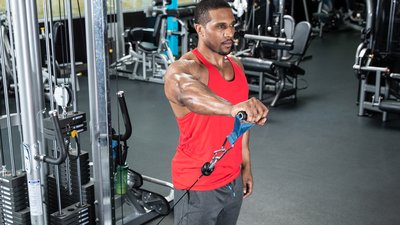Some people will tell you that the movement is all that matters, and the weight you load it with could be anything. Dumbbell, cable, band, or kitten—it's all pretty much the same, right?
Not quite. For certain movements, the implement can definitely make a big difference! In this article, I'll explain how the cable versions of five popular isolation exercises offer a distinct advantage over their dumbbell equivalents.
Now, before you get your posing trunks in a bunch, I'm not saying the dumbbell exercises highlighted below aren't beneficial or that you shouldn't use them—far from it! I use them and have written about various ways I use them in some of my previous articles like "Smart Dumbbell Lifting: Iso-Dymanic Training." I'm saying that if you're choosing between which version to prioritize in your training, or you're short on time and looking for the movement that offers the most bang your buck, the cable is the better choice.
It's All About the Strength Curve
1. Cable Lateral Raise
Performed correctly, this movement offers two advantages over dumbbell lateral raises. First is that the cable version provides tension on the working muscles at the bottom portion of the exercise. In contrast, there's little to no tension at the bottom when holding a dumbbell by your side.
That much you may already know. But here's what's really special: The cable version fits better with what's known as "strength curve," whereas the dumbbell version works against it.
Here's what I mean. There's a principle of physiology known as the "length-tension relationship" or the "length-tension curve," which describes how muscles are strongest in their mid-range of motion, and weaker in their shortened range (contracted position).[1] Ideally, you'd like the lever arm of a movement—or the distance between a weight and the joint responsible for moving it—to be longest at the point where you're strongest, and less where you're weaker. But that's often not the case.
When performing dumbbell lateral raises, your body feels the weight to be heaviest when the arm is parallel to the floor, because the lever-arm is longest there. But that's also the point where your muscles are weakest. This gives you the least mechanical advantage over the load, and it's why you'll so often see lifters lift a weight partway with good form, and then jolt it the rest of the way up.
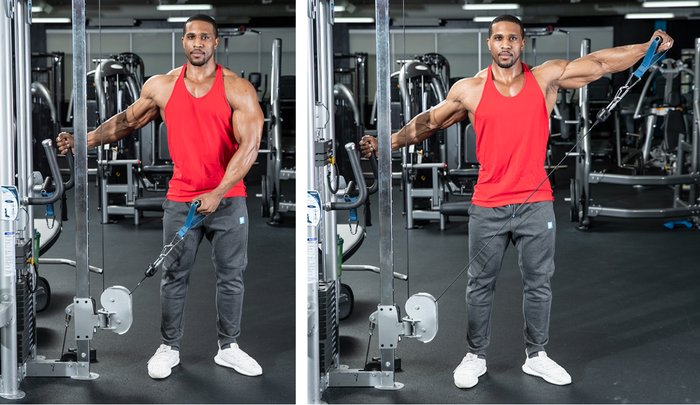
So, what's so special about cables? If you set the cable at about ankle height, the resistance makes them harder much lower in the range of motion, when your arm is perpendicular to the cable itself. You get more resistance where you're strongest, and less where you're most limited.
This certainly doesn't make dumbbell lateral raises somehow bad, dangerous, or ineffective, it just means you have to be more creative to get the most out of the movement. For instance, as I explain in the article "4 New Ways to Boost Time Under Tension," I like holding the top position for 8-10 seconds with a dumbbell and then doing 8-10 reps.
2. Cable Front Raise
Since front raises and lateral raises are such similar exercises, the same reasoning works here. This is also another move where lifters tend to go to heavy, and when they reach the point of maximum difficulty, they just jerk the weight up farther.
To be clear, "cheating" like this has its place, as I explain in my article "Cheat-centrics: A Better Way to Perform Cheat Reps." But that place isn't at the core of your training. You'd be better served by performing solid, controlled reps with the cable than going to war against the dumbbells.
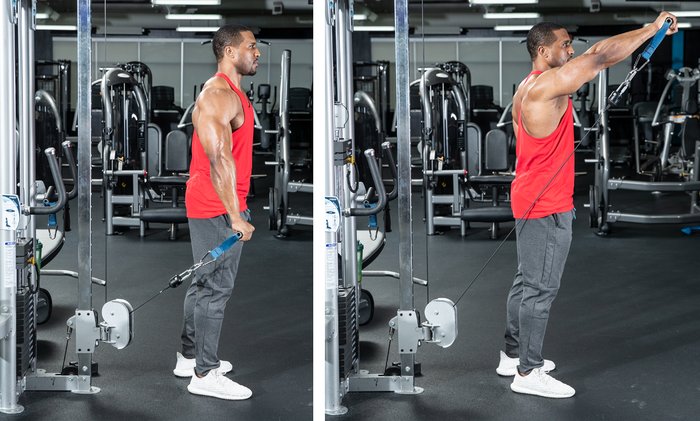
Take the same approach as you do with lateral raises: anchor the handle low, at around ankle level, and use a weight you can control.
3. Rear-Delt Cable Fly
Everything I wrote about lateral and front raises applies again here. And because the rear delts are such small muscles, it's even more important to get the details right when training them. Otherwise, you'll find yourself in that camp of lifters complaining that they only feel rear-delt moves in their traps.
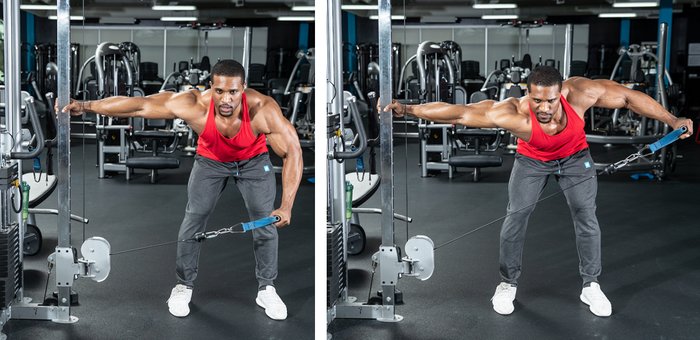
Once again, try to replicate that 45-degree angle of pull from around ankle height. And to further engage the rear delts, hold the handles with the palms facing one another, rather than holding onto the balls on the cable or some other pronated (palms down) grip. As I explained in the article "The 7 Best Shoulder Exercise You're Not Doing," a neutral grip has been shown to increase rear-delt activation.
4. Cable Triceps Kick-Back
Dumbbell kick-backs are a good exercise. Kick-backs using a cable, with the handle attached at about knee height, is a great exercise. In fact, I included the cable kick-back in my article "The 6 Grittiest Triceps Exercises You're Not Doing," even though most lifters probably wouldn't consider this movement anything close to "gritty" at first glance. Here's how I explained it there:
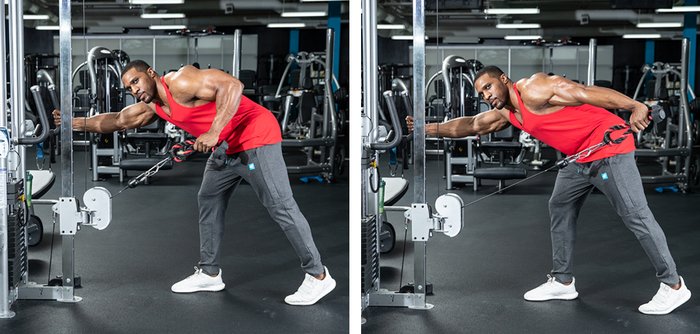
"The dumbbell gives you no loading demand on the triceps at the bottom of the exercise, which is where you're strongest. And, at the top of the range of motion, where you're weakest, the weight is at its most challenging. This is why so many people are forced to cheat (by using momentum or dipping their arm or torso farther forward) at the top of the range of motion when doing dumbbell kick-backs.
"I would recommend simply using a low cable instead, and setting it up at roughly a 45-degree angle to the floor. This not only loads the bottom position of the exercise, it also creates the longest lever arm in the mid-range aspect of the motion and creates a short lever arm at the top of the action."
That's what smart cable work is all about: Getting more resistance where you're strongest, and less where you're weakest. But at no point in the cable movement will there be no resistance.
5. Cable Pec Fly
Everything I said about the other movements applies here: constant tension, greater range of motion, and resistance throughout the movement. But there's another reason why the cable pec fly is a better choice than the dumbbell fly, and it's all about programming.
When do most lifters do dumbbell flyes? Right after they do dumbbell presses. After all, you already have the bench set up in front of the dumbbell rack—why not use it again?

The problem is that dumbbell pec flyes are basically the same exercise as dumbbell bench presses when it comes to how they load your chest. Both exercises create the most tension on the pecs when your biceps bone is parallel to the ground, which is 90 degrees to the force vector (i.e., gravity). The only reason you can use much more weight when doing a dumbbell bench press, in addition to the triceps being able to contribute, is mainly because the weight is much closer to your shoulder joints, giving your pecs and front delts a much better mechanical advantage.
So, from a practical perspective, if you're using dumbbell presses in your workout, it's redundant to also perform dumbbell pec flyes. However, cable pec flyes load the horizontal shoulder abduction movement differently, allowing you to give your chest a novel stimulus after any pressing movement.
Really want to feel how effective this movement can be? Perform it as go-pause sets, like I recommend in "The Gritty Workout Your Upper Body Needs." Perform 8-10 smooth, controlled reps, and then hold the final contraction for 8-10 seconds. Good luck doing that with dumbbells!
If you liked these exercise tips from Nick Tumminello, check out his Bodybuilding.com BodyFit Elite program True Muscle: 9 Weeks to Elite Fitness.
References
- Houglum, P. A., & Bertoti, D. B. (2011). Brunnstrom's clinical kinesiology. FA Davis.

